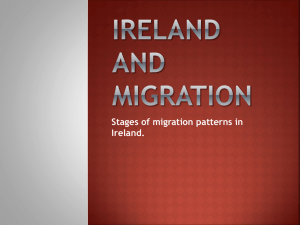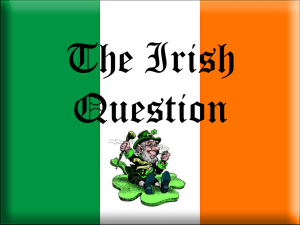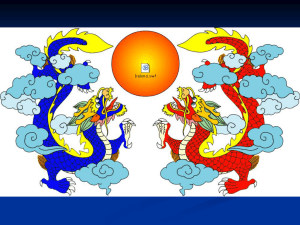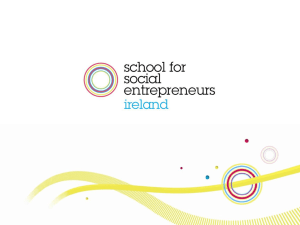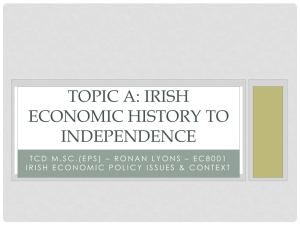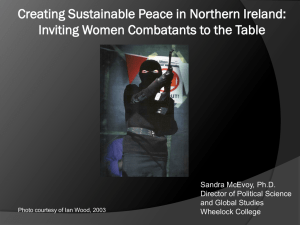The Celtic Tiger A Macro and a Micro View
advertisement
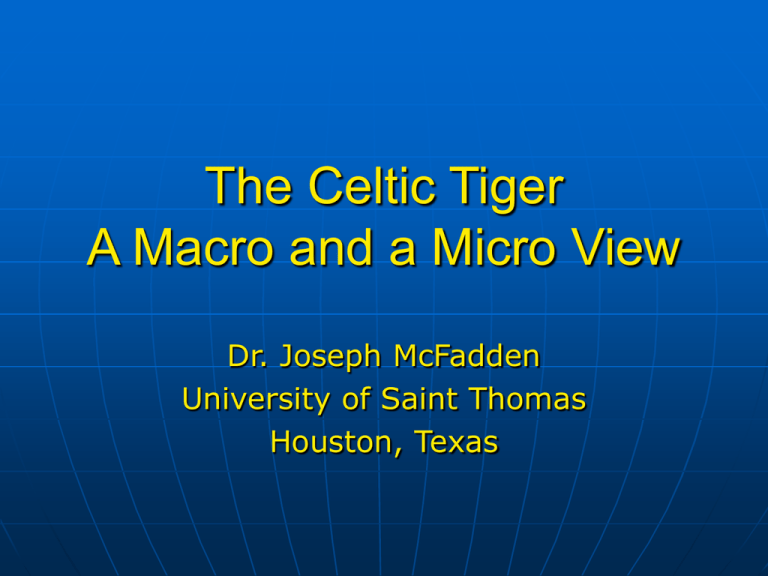
The Celtic Tiger A Macro and a Micro View Dr. Joseph McFadden University of Saint Thomas Houston, Texas The Celtic Tiger – A Macro Look In 2000, Ireland was selected as the most global nation in the world Two strong categories: economic integration and personal contact with internationalism Ireland also ranked #1 on a recent survey on a happiness scale A successful combination of globalization and happiness! The Celtic Tiger Ireland began to flourish in the 90s Positive response to the criticism of the Whitaker Report Consultants had three strong recommendations: break dependence on Britain, stop being economic illiterates, and create a more favorable economic development climate Economic Progress in Ireland The nation represents a true economic miracle Is Ireland a model? A pattern of dynamic economic success can be seen when comparing the pre-Celtic world with the Celtic Tiger World Ireland – 1973 and pre-Celtic Days GNP – 59% that of the European Community average! Per capita income among the lowest in Europe 61% of exports went to the UK, only 9% to other European nations Agriculture: limited electricity and tractors Economic isolation Ireland – 1990s and Beyond GNP – grew by 73%, an average of 9% growth per year in a decade! Unemployment holding at 5%; Ireland imports workers, and 10% or more of the population is foreign born Exports – 68% to EU (22% to UK) and 15% to US Irish middle class grew by 25% Factors of Economic Progress Transnational Approach Laws and Incentives Education Targeting Societal Support National Partnership Agreements European Union Transnational Approach Welcoming companies that manufacture in Ireland for European markets and beyond New money is brought in, and companies borrow little or no money from Ireland An explanation as to why Ireland’s GDP is 25% larger than its GNP Laws and Incentives Very attractive corporate income tax Lowest corporate tax rate in the EU! Permits and protects a high rate of profit Fiscal restraint to hold down inflation Minimal restrictions on business operations Maximum integration into European economy Education Heavy investment especially in Secondary and third level education with paid tuition for all enrolled Emphasis on science and technology Students earning admission have funding to support them Educational attainment established as a national priority! Targeting Ireland has targeted key business areas that are likely to remain Used tax and other incentives to go after the markets they desired Key targeted areas: Computers, Pharmaceuticals, Electronics, Telecommunications, and the most recent International Logistics and Shipping Societal Support Progress could not be achieved without the people’s support High income taxes Irish provincialism and ambivalence regarding capitalism have been overcome Globalization does not necessarily conflict with national values National Partnership Agreements National agreements are negotiated and voted on by the Irish Congress of Trade Unions (ICTU) A “National Partnership Agreement Towards 2016” is in progress It places specific emphasis on social justice European Union Especially in the areas of agriculture support, infra-structure projects, transfer funds, and standardization The kind of planning that other nations did under the Marshall Plan Throughout Ireland one can see the blue flag of the EU Ireland identified as the Mississippi of the EU, and funds flowed in Concerns Persistence of poverty, income disparity, acquired debt, and high unemployment among some segments of Irish society How is economic progress affecting Irish values? General EU concerns regarding unfair tax advantage that Ireland enjoys Contrast IR with NI The Celtic Tiger – A Micro Look How did economic development work on the ground? Targeted industry: Logistics/Maritime Shipping Creation of the Irish Maritime Development Office (IMDO) Purpose: to attract companies of the highest operating standards to Ireland The Strategy in Practice Ireland conducted a thorough study of the history of the industry in question They found archaic nationalistic requirements and a muddled Shipping Tonnage Tax situation As a response, Ireland avoided restricting requirements and devised an attractive Shipping Tonnage Tax The Strategy in Practice Education is promoted in order to stimulate careers in maritime industry Ireland has also attracted a small but highly qualified dedicated staff of young professionals This team tries to meet the real needs of potential operators and develops relationships with clients Benefits for Companies Lower corporative tax rate Pro-business environment English speaking Euro global economy Open-minded, well educated employees Emerging maritime knowledge environment Educational system geared to serving international companies Benefits for Companies New maritime college to provide skilled workers Opportunities to teach Assistance in infrastructure facility needs Office space in Dublin at attractive rates Attractive labor rules Positive working environment Conclusions and Comments Having no strong history as a maritime nation, Ireland is working hard to overcome the disadvantage Ireland provides the four requirements for business abroad: security for employees, fairness in the playing field, a qualified work force, and business incentives Conclusions and Comments Exportation of the Celtic Tiger model is highly unlikely Struggling nations can learn from Ireland, but the model must be adapted to specific conditions Irish case study represents a remarkable improvement that has placed Ireland in the forefront of globalization in the 21st century
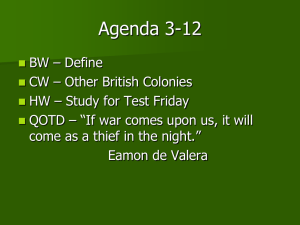
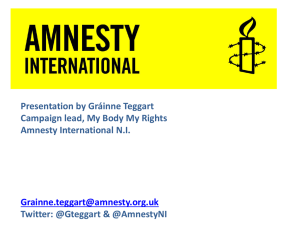

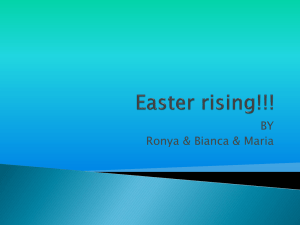
![South east presentation resources [pdf, 7.8MB]](http://s2.studylib.net/store/data/005225551_1-572ef1fc8a3b867845768d2e9683ea31-300x300.png)
